4.2.2 BIOPSYCHOLOGY
1/108
There's no tags or description
Looks like no tags are added yet.
Name | Mastery | Learn | Test | Matching | Spaced |
|---|
No study sessions yet.
109 Terms
What is the human nervous system?
The specialised network of cells in the human body and is our primary internal communication system. It has two main functions: to collect, process and respond to information in the environment and to co-ordinate the working of different organs and cells.
What are the strands of the human nervous system?
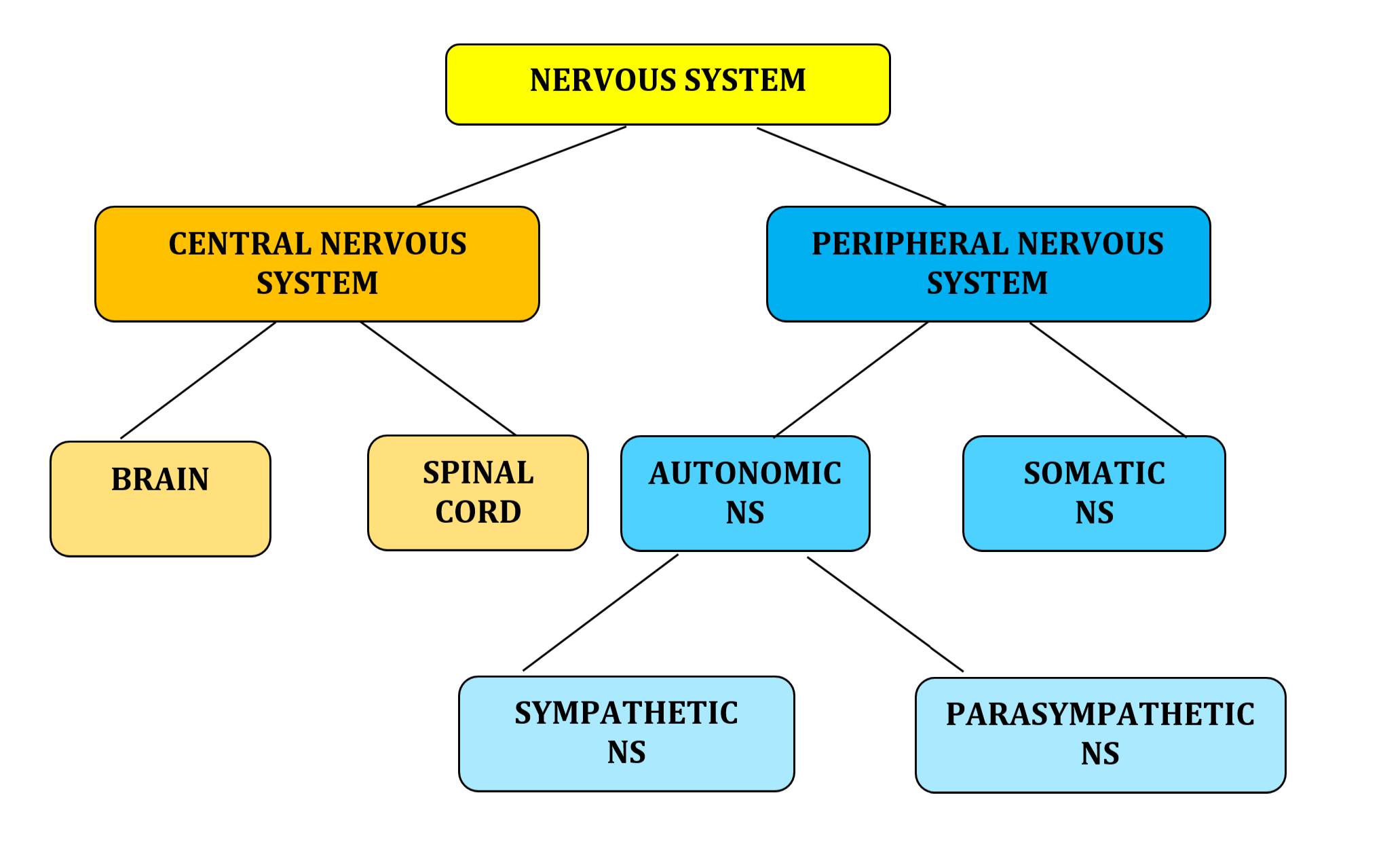
What is the central nervous system made up of? Explain it. What are the 2 main functions of the CNS?
The CNS is made up of the brain and the spinal cord.
The brain is the centre of all consciousness. The brain’s outer layer, cerebral cortex, is highly developed in humans. The brain is divided into 2 hemispheres.
The spinal cord is an extension of the brain and is responsible for reflex actions.
The two main functions of the CNS are the control of behaviour and the regulation of the body’s physiological processes.
What is the peripheral nervous system? What does it do?
The PNS transmits messages via millions of neurons to and from the CNS. It’s further sub-divided into the somatic and autonomic nervous systems.
What do the somatic and autonomic nervous systems do?
Somatic - 12 pairs of cranial nerves and 31 pairs of spinal nerves, responsible for sensory and motor processing, which means carrying sensory and motor information to and from the spinal cord.
Autonomic - involuntary actions which governs vital functions in the body such as breathing, heart rate, digestion and stress responses.
The ANS is sub-divided into two more systems. What are they?
The parasympathetic and the sympathetic nervous systems. They work antagonistically. While the parasympathetic ns works to maintain/conserve body energy and functions the sympathetic ns prepares the body to expend energy for fight or flight.
Give some examples of what the sympathetic nervous system does in preparation for fight or flight.
Slows digestion, inhibits saliva production, increases heart rate, dilates pupils etc.
Give some examples of what the parasympathetic nervous system does when coming down from fight or flight.
Increases digestion, decreases heart rate, increases saliva production, constricts pupils etc.
What is the fight or flight response?
This response is hard-wired into our brains and represents an adaptation fine-tuned by natural selection, designed to protect us.
What is bad about the fight or flight response? (Cannon)
We burn more calories under fight or flight which is bad because:
interfered with ancestors trying to find food, forming alliances and mating
prone to infection due to the immune system going down
How do the endrocrine system and the ANS work together?
The acute stress response occurs as soon as we’re exposed to some sort of threat. As soon as the hypothalamus perceives immediate stressors it activates the ANS to prepare us for fight of flight.
How does the sympathetic nervous system and the endrocrine system work together?
When aroused, the SNS activates the adrenal glands. It also releases noradrenaline to activate the major organs and glands to prepare the body for rapid action.
What do the adrenal glands look like and how do they function?
Adrenal glands are made up of an adrenal medulla in the centre and adrenal cortex around the outside. The adrenal medulla releases adrenaline which further prepares the body by boosting oxygen and glucose supplies as well as suppressing digestion.
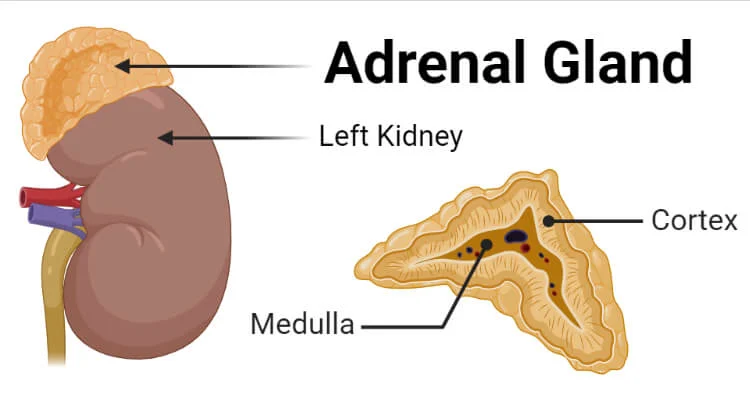
What is a neuron?
Neurons are information messengers. They use electrical impulses and chemical signals to transmit information between different areas of the brain and between the brain and the rest of the nervous system.
What are the 3 basic parts of a neuron?
The cell body, the axon and the dendrite.

What are the three types of neurons?
Sensory
Relay
Motor
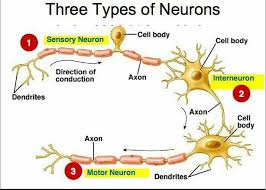
In a neuron, what does a 1.a nucleus do, 2. a dendrite do and 3. an axon do?
nucleus - the control centre of the cell, which controls the cell’s chromosomal DNA.
dendrite - receives the nerve impulse or signal from adjacent neurons
Axon- where the electrical signals pass along
In a neuron, what does a 1. myelin sheath do, 2. nodes of ranvier do and 3. terminal buttons do?
myelin sheath - insulates/ protects the axon from external influences that might effect the transmission of the nerve impulse down the axon.
nodes of ranvier - these speed up transmission of the impulse by forcing it to “jump”
terminal buttons - send signals to an adjacent cell
What is the function of the motor neuron and what is the length of fibres?
The motor neuron carries messages from the CNS to effectors, like glands and muscles. It has short dendrites and long axons.
What is the function of the relay neuron and what is the length of fibres?
The relay neuron transfers messages from the sensory neurons to other interconnecting neurons or motor neurons. It has short dendrites and short or long axons.
What is the function of the sensory neuron and what is the length of fibres?
A sensory neuron carries messages from the PNS to the brain and spinal chord. It has long dendrites and short axons.
What does a synapse between two neurons look like?
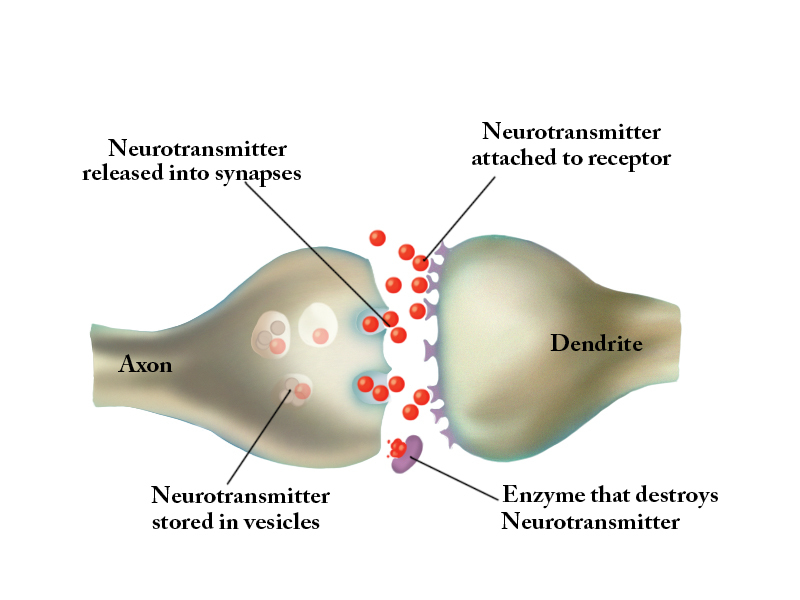
What are neurotransmitters?
Neurotransmitters are chemicals released from a synaptic vesicle into the synapse by neurons. They affect the transfer of an impulse to another nerve/muscle. The are either reuptaken or broken down by an enzyme
What is the process of reuptaking?
Neurotransmitters are “taken back up” into the terminal buttons of the pre-synaptic neuron by transport proteins.
What is an action potential?
An action potential occurs when a neuron sends information down an axon, away from the cell body. The action potential is an explosion of electrical activity - this means that a stimulus causes the resting potential to move forward.
What is excitation and inhibition?
Synaptic connections can be excitatory or inhibitory - the difference lies in the action of the neurotransmitter at the postsynaptic receptor.
Excitatory - they make it more likely the next neuron will fire
Inhibitory - they make it less likely the next neuron will fire
What is summation?
Summation is a control system which controls where excitatory and inhibitory actions occur.
What is synaptic transmission?
Once an action potential has arrived at the terminal button at the end of the axon, it needs to be transferred to another neuron or to tissue. It must cross a gap between the presynaptic neuron and the postsynaptic neuron - the synapse. This includes the pre and membrane of the postsynaptic neuron and the gap in between.
What is the synaptic gap?
The physical gap between the pre- and postsynaptic cell membranes.
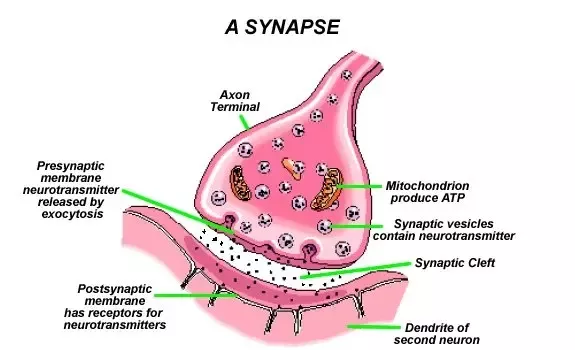
What are synaptic vesicles?
At the end of the axon of the nerve cell are a number of sacs known as synaptic vesicles which contain chemical messengers which assist in the transfer of the impulse.
What is the process of exocytosis?
As the action potential reaches the synaptic vesicles, it causes them to release their contents.
What does the released neurotransmitter do after is has been diffused across the gap between the pre- and postsynaptic cell? What does this cause?
It binds to specialised receptors on the surface of the cell that recognise it and are activated by that particular neurotransmitter. Once activated, the receptor molecules produce excitatory or inhibitory effects on the postsynaptic neuron.
How long does synaptic transmission take?
A fraction of a second.
What is the endocrine system?
A network of glands throughout the body which secrete hormones to create a chemical communication system via the blood stream.
Which side of the brain controls what side of the body?
Activity on the left hand side of the body controls the right hemisphere and vice versa.
How large is the cerebral cortex? What is it compared to?
Like a tea cosy, its often 2-3mm thick.
What are the lobes of the brain? What is the acronym?
Fat
Patricia
Tumbles
Over
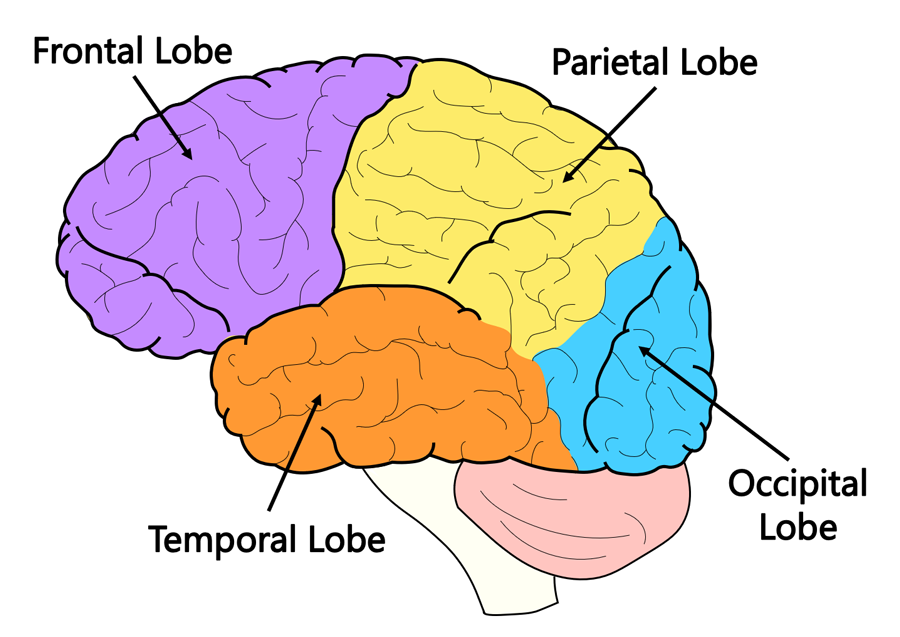
What does the frontal lobe control? What does damage do to this area?
This controls voluntary movements. Damage to this area may result in a loss of fine motor control.
What does the parietal lobe control?
This is the somatosensory area which receives all sensory input from the body. Sensory neurons send all their information to the somatosensory cortex for processing.
What does the occipital lobe control? What would happen if this area was to get damaged?
This is the area which processes visual inputs. The right eye sends info to the left hemisphere and vice versa. Damage could result in blindness.
What does the temporal lobe control? What would happen if this area was to become damaged?
Dominated by auditory information, this is where speech is analysed. Damage could result in hearing loss and inability to create/process language.
Where are Broca and Wernicke’s areas?
Broca’s area = left frontal lobe towards the front
Wernicke’s area = left frontal lobe.
What is Broca’s/Wernicke’s aphasia?
Broca’s aphasia = speech which you can understand by its non-fluent and broken (Broca=broken)
Wernicke’s aphasia = fluent speech, but broken/nonsense meaning
What evidence is there for the localisation of brain function?
clinical case studies show a loss of function to the Broca’s area = Broca’s aphasia and Wernicke’s area = Wernicke’s aphasia. This supports localisation
FMRIs - older research on lang. centres in brain shows activation in the brain regions when healthy participants do language tasks.
What weaknesses are there for the localisation of the brain?
functions like consciousness can’t be localized because there isn’t a specific place
reductionist
deterministic
ethical issues
Lashley (1950) higher cognitive functions are distributed in a more holistic way rather than localized.
What does hemispheric lateralisation mean?
The idea that 2 halves of the brain are functionally different and that certain mental processes and behaviours are mainly controlled by one hemisphere rather than the other.
What and who was Sperry’s experiment’s on?
A quasi experiment on 11 participants who had all had corpus calloscopy’s (severed corpus callosm). This is was to investigate what would happen if the 2 hemisphere’s where split and couldn’t communicate.
What tasks did the pps have to do in Sperry’s experiment?
The left eye would be covered and the pp would either have to point, draw or say the object they had been presented with. The same happened with the right eye.
What were the findings of Sperry’s experiment?
Information presented to the left hemisphere (right eye) could only be identified by a spoken answer. Info to the right hemisphere (left eye) could be drawn or pointed to with their left hand.
What do the findings of Sperry’s experiment suggest?
That the hemisphere’s can work independently and supports the theory that the language center is in the left hemisphere.
What are the weaknesses of Sperry’s research?
sample size = smaller means that there is a bigger chance results were impacted by pp variables. Harder to generalize and lower internal validity.
lacks mundane realism - low external validity
no control group = can’t establish cause-and-effect
What is the left and right hemispheres known for? Give characteristics.
Left: analytical thought, verbal, rational thought, cautious/planner, detail-oriented
Right: intuitive, holistic, emotional, creative, impulsive/adventurous
What is plasticity (neuroplasticity or cortical remapping)?
The brains tendency to change/adapt (functionally and physically) as a result of an experience and new learning. The brain has the ability to change throughout life.
What are the differences in infant plasticity and adult plasticity?
During infancy, the brain has a rapid growth in the number of synaptic connections, peaking at about 15,000 connections at ages 2-3. This is about twice as many and the adult brain.
What does aging mean for plasticity?
Rarely used connections are deleted and vice versa. This process is called synaptic pruning.
What happens in the functional recovery of the brain after trauma?
If someone becomes ill/damages and area of the brain, other areas may have to compensate for the missing/damaged areas: the healthy brain takes over.
What is spontaneous recovery?
Happens very quickly after trauma and after a while it may slow down (in which case therapy would be needed).
What was Maguire’s study of the hippocampus of Taxi drivers in London?
2000
compared taxi drivers MRI scans to a control group of 50 normal men
What were the results of Maguire’s study?
taxi drivers had significantly larger posterior hippocampi than the normal men
due to the extensive use of the hippocampus and their experience with spatial navigation.
What was Kemperman’s rat study?
1998
investigated whether a rich environment could alter the number of neurons in the rats brains.
rat cage vs enriched environment
How does Kemperman’s study support plasticity? (Results)
increase of neurons in the rats hippocampus in the complex environments compared to those in lab cages
What is the strength of plasticity? What research supports this?
plasticity can happen over a lifetime, meaning any age group can learn
Bezzola (2012) showed those aged 40-60 after 40 hours of ‘gold’ training their neural representations of the movements of these inviduals had shown to increase.
What is a weakness of plasticity? Research?
Plasticity is not always seen as a positive: there are negative side effects.
Ramachandran and Hirstein (1998) argue that those wo loose a limb can often experience phantom limb syndrome. This is thought to be because of the cortical reorganization in the somatosensory cortex that occurs as a result of limb loss
What are the four ways of studying the brain?
FMRIs
EEGs
ERPs
Post-mortems
What does FMRI stand for? What is the procedure?
Functional Magnetic Resonance Imaging
measures brain activity while a person performs a task
How do FMRIs measure brain activity?
measuring changes in blood flow in particular areas which indicates increased neural activity.
More activity means an increased demand for oxygen.
The brain increases blood flow to these areas of increased activity, delivering oxygen and red blood cells.
Maps can be produced showing which areas of the brain are involved in a particular mental activity.
How long are FMRIs?
40-55 minutes.
What are the advantages of an FMRI?
non-invasive/harmful
reliable measure of psychological processes
useful in finding psychological phenomena
What are the disadvantages of an FMRI?
not a direct measure of neural activity so not a truly quantitative measure
overlooks the networked nature of the brain
What does EEG stand for? What is the procedure?
Electroencephalogram
measures electrical activity in the brain
What does the equipment in an EEG do?
Electroduces placed on the scalp detect small electrical charges resulting from activity of brain cells. When electrical signals from the different electrodes are graphed over time, the representation is an EEG.
What are EEGs used for?
To detect various types of brain disorder or to diagnose other disorders that influence brain activity.
What are the 4 EEG patterns? How do they correlate to behaviour?
Alpha, beta, Delta and theta waves.
awake but relaxed = alpha
psychological arousal = beta
rem sleep = beta
sleep = delta and theta
light—> deep sleep = decrease of alpha waves replaced by theta then delta.
How long are EEGs?
20-40 mins
What are the advantages of an EEG?
provides real time brain activity rather than a passive image (acurate measuring of a particular task)
useful in clinical diagnosis
What are the disadvantages of an EEG?
can only detect activity in the superficial regions
not ethically permissible to place implants to achieve deeper images with humans - too invasive
not useful for pinpointing exact source of activity
What does ERP stand for? What is the procedure?
Event-related potential.
small voltage changes in the brain that are triggered by specific events/stimuli.
How are ERPs found?
It’s difficult to distinguish between other electrical activity and a specific response so many presentations of the stimulus is calculated and responses are averaged together. This effectively cancels out background neural ‘noise’ to make the ERP stand out more clearly.
What are the 2 categories of ERP?
Sensory ERPS - waves occurring within the first 100 milliseconds after the stimulus is presented (initial response to stimulus)
cognitive ERPS - waves occurring after the first 100 milliseconds (evaluation of the stimulus)
How long to ERPs take?
12-16 weeks
What are the advantages of an ERP?
provides a continuous measure of processing, making it possible to determine how processing is affected by a specific experimental manipulation.
measures the processing of the stimulus, even without behavioural reactions
makes it possible to covertly moniter processing
What are the disadvantages of an ERP?
ERPs= small and difficult to pick out, so large numbers of trials needed to gather reliable data
only sufficiently strong voltage changes generated across the scalp that are recordable
important electrical activities occurring deep in the brain aren’t recorded
What are post-mortems?
Used to establish the underlying neurobiology of a particular behaviour where the researchers can examine the brain to look for abnormalities that might explain the behaviour which aren’t found in control individuals.
Why are post-mortems useful?
They have made it possible to identify some of the brain structures involved in memory: Annese’s post-mortem of HM confirmed his inability to store new memories was linked to lesions in the hippocampus.
Also been used to find links between psychiatric disorders and underlying brain abnormalities.
What are the advantages of a post-mortem?
allows for more detailed exams of the anatomical and neurochemical aspects of the brain.
plays a significant role in the understanding of mental health disorders
What are the disadvantages of a post-mortem?
people’s death can affect results
length of time between death and exam can affect results
retrospective - already dead, therefore unable to follow up concerning a possible relationship between brain abnormalities and cognitive functioning
What is a biological rhythm?
A pattern of changes in the body’s activity that conforms to a cyclical time period. Our biological rhythms are influenced by our internal body clock (endogenous pacemakers) and external changes to the environment (exogenous zeitgebers).
What are circadian rhythms?
A cycle that tells our body’s when to sleep, rise and eat. It regulates many physiological processed and is influenced by environmental cues like sunlight and temperate.
What happens when a person’s circadian rhythm is disrupted?
Sleeping and eating patterns run amok. The adverse health effects could be an increased chance of cardiovascular events, obesity and a correlation with neurological problems like depression or bipolar disorder.
Who studied the natural rhythms of human life in a cave study? How long was the initial study?
Siffre’s cave study lasted 63 days.
What did Siffre’s cave study consist of?
Siffre did not have access to a clock, calendar, information from the outside world or the sunlight. He slept and ate whenever his body told him too.
What were the average results Siffre concluded from his experiments?
That our biological clock is more than 24 hours, ranging from 25 hours to 48 hours.
What did Siffre find in his 6 month underground study?
That his rhythm increased up to 48 hours.
Give the 6 strengths of circadian rhythms.
the case study provides rich detail
foundation for other studies
application to shift work+drug treatments and times to take drugs
scientific methodology - EEGs
holistic
qualitative and quantitative data
Give the 6 limitations of circadian rhythms.
ethical issues of staying underground
pp variables
difficult to generalise
low mundane realism
investigator effects
temporal validity
What are infradian and ultradian rhythms?
Infradian = a type of biological rhythm with a frequency of less than one cycle in 24 hours, such as the menstrual cycle and SAD.
Ultradian = a type of biological rhythm with a frequency of more than one cycle in 24 hours, such as the stages of sleep.
What was McClintock’s method for her study on the menstrual cycle?
1971
35 women living together in dorms
investigated whether external factors can influence the menstrual cycle
What did McClintock find in her study?
Time spent together acts as an exogenous zeigteber, so women synced cycles.
What are pheromones?
An odorless chemical substance that we release into the environment that affects the behaviour of others. It’s also an exogenous zeitgebers.
What is the evaluation of McClintock’s results?
Lack reliability - when done again on Chinese women, it found no synchronization of periods